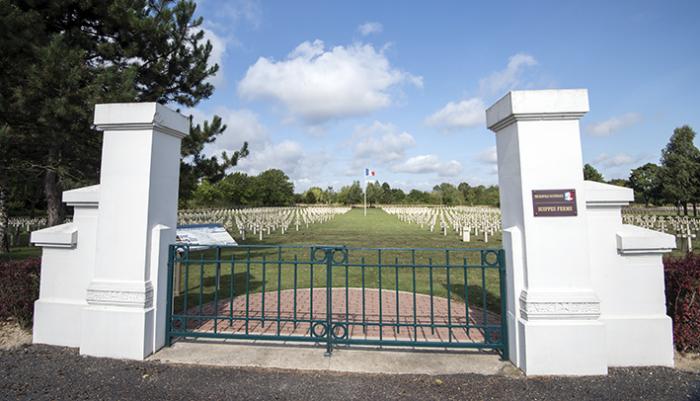
La Ferme de Suippes National Cemetery. © ECPAD
Click here to view the cemetery’s information panel here 
Set beside the Chalons-Vouziers-Rethel road, La Ferme de Suippes National Cemetery contains the bodies of French soldiers killed in the fighting in Champagne in the First World War and during the campaign of June 1940. Due to a shortage of space in the other cemeteries, it was established after the war on part of what was formerly the site of the Mourmelon camp, and was completed in 1932.
In 1956, the bodies of servicemen killed in the Second World War and originally buried in other military cemeteries in the area were transferred here, and in 1964, those from the military plot in Épernay. The cemetery holds nearly 10 000 bodies, including 7 400 French in individual graves and over 500 in ossuaries, one Belgian and three Russians. From the Second World War, more than 1 900 French soldiers are buried in individual graves.
Among them is the poet Marcel Nenot (grave 2721), who died on 3 October 1915 in the Vistule Trench.
The Battles of Champagne, 1914-18
The Franco-British counter-offensive on the Marne in September 1914 and the failed “Race to the Sea” signalled the end of the mobile war on the Western Front. To protect themselves from artillery fire, the belligerents dug in.
In the winter of 1915, General Joffre launched a series of attacks on the German trenches in Champagne, all of which failed. Intended to chip away at the German lines in the sectors of Souain, Perthes, Beauséjour and Massiges, these were particularly bloody operations. The front didn’t budge.
In the summer, to break the deadlock and provide support to the struggling Russians on the Eastern Front, Joffre, true to his doctrine, decided to launch a fresh offensive. Supported by another operation in Artois, the main operation took place on the vast, arid chalk plain of Champagne, on a front spanning 15 miles, from Auberive to Ville-sur-Tourbe. It was carried out by the 2nd and 4th Armies, against the Germans of the 3rd Army, who were dug into solid trenches. Further back, on the opposite slope, was a second position, hidden from aerial reconnaissance and out of range of the French guns.
After an artillery bombardment lasting three days, the attack was launched on 25 September. The French took the first lines easily, with the exception of the Butte du Mesnil. To the east of the formation, the Colonial Division took “Main de Massiges”, a key element in the German formation.
But the momentum was broken by the second position, which remained intact. The exhausted French troops had to go on fending off powerful counter-attacks, during which the two armies lost 138 000 men. By November, difficult weather conditions and the sheer scale of the losses forced Joffre to abandon the idea of carrying out further attacks. The front returned to relative calm.
The German offensive of July 1918 put this front once more at centre stage. Reims, under continuous fire from German artillery, came under threat once again. But General Foch, engaging all of his forces from the Meuse to the North Sea, and with growing support from the Americans, conducted a broad manoeuvre. In the Reims area, General Gouraud’s army successively took Navarin, Tahure, Le Mesnil and Sommepy, then advanced towards the Ardennes until November 1918. Today, the Suippes area preserves the memory of this bitter fighting, through the ruins of the villages of Perthes, Hurlus, Mesnil, Tahure and Ripont.